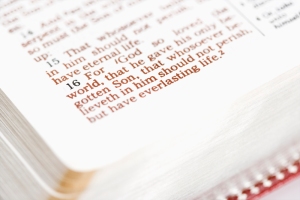Novelist Yann Martel’s book Life of Pi (now a major motion picture) embodies the popular notion that all religions are simultaneously true. The story’s young protagonist embraces aspects of multiple faiths (Hinduism, Islam, and Christianity), viewing these beliefs as equally valid but different paths to God. Unfortunately religious pluralism fails to appreciate the profound problems associated with it.
 1. The World’s Religions Are Different
1. The World’s Religions Are Different
Many faiths do share some common beliefs and moral values. However, fundamental and irreconcilable differences divide them on many crucial issues, including the nature of God, the source and focus of revelation, the human predicament, the nature of salvation, and the destiny of humankind. Consider, for example, these varied views on the human predicament:
- Hinduism claims that people are under the false illusion that they are distinct and separate from God.
- Islam asserts that sin results from human weakness and willful disobedience, not an inborn tendency.
- Christianity teaches that sin is inherent in human nature and cannot be overcome or compensated for by good works.
2. The World’s Religions Are Irreducible
 Some people argue that no particular religion speaks for God. Instead, they suggest that when we reduce the world’s beliefs to their lowest common denominator, a consensus emerges that reflects God’s voice. However, in light of this complex array of religious perspectives, this dubious reductionist approach is fraught with problems. Religions are so diverse in belief and worldview orientation that they defy attempts to synthesize them to a single common theme or essence. In fact, such reduction would actually cost the various religions the features that make them unique and appealing in the first place.
Some people argue that no particular religion speaks for God. Instead, they suggest that when we reduce the world’s beliefs to their lowest common denominator, a consensus emerges that reflects God’s voice. However, in light of this complex array of religious perspectives, this dubious reductionist approach is fraught with problems. Religions are so diverse in belief and worldview orientation that they defy attempts to synthesize them to a single common theme or essence. In fact, such reduction would actually cost the various religions the features that make them unique and appealing in the first place.
3. The World’s Religions Are Contradictory
 The difficulty with trying to homogenize religions is magnified by the fact that the essential beliefs held by the various faiths contradict one another. Even the religions that hold the most theological ground in common—such as the monotheistic faiths (Judaism, Christianity, Islam)—take positions that clash logically with one another. Christianity, the world’s largest religion, affirms that Jesus Christ is God incarnate (God in human flesh). But the world’s second largest religion, Islam, asserts that Jesus was merely a human being. Traditional Judaism also denies Christ’s deity.
The difficulty with trying to homogenize religions is magnified by the fact that the essential beliefs held by the various faiths contradict one another. Even the religions that hold the most theological ground in common—such as the monotheistic faiths (Judaism, Christianity, Islam)—take positions that clash logically with one another. Christianity, the world’s largest religion, affirms that Jesus Christ is God incarnate (God in human flesh). But the world’s second largest religion, Islam, asserts that Jesus was merely a human being. Traditional Judaism also denies Christ’s deity.
Based on the law of noncontradiction, Jesus Christ cannot be both God incarnate (Christianity) and not God incarnate (Judaism, Islam) at the same time and in the same respect. Contradictory religious claims have opposite truth-value, meaning that they negate or deny each other. Therefore, exactly one can be true and the other false. Accordingly, Jesus Christ must either be God incarnate or not be God incarnate; there is no middle position possible (the law of excluded middle).
As uncomfortable as the differences among the world’s religions may make us, the claim that they are all simultaneously true is not a reasonable option open to us.
Resources:
For more concerning the challenge of religious pluralism, see my new book, 7 Truths That Changed the World. For comparisons between Jesus Christ and leaders of other major world faiths, including those featured in Life of Pi, see my “Religious Faces in the Crowd” article series (originally published in RTB’s e-zine, New Reasons to Believe):
- Hinduism: “The Prince and the Lord”
- Islam: “The Prophet and the Son of God”
- Buddhism: “The Buddha and the Christ”
- Confucianism: “The Sage and the Savior”

You haven’t understood the concept of “different paths to God.” It means religions are paths. So your first point simply says that the paths are different, and that’s understood. Two different paths can take you to the same place, of course.
Your second point is also beside the point. No religion contains God and no combination of religions “reduce to” God. Religions are paths. No path contains the destination.
Again, your third point misunderstands the concept about paths. Columbus could visit the New World by traveling either east or west. East and west contradict each other! But they can both lead you to the New World.
John:
Your mistake is that you are equating geographical-physical paths with metaphysical-religious paths. The two are not the same. This is known as the informal logical fallacy of equivocation.
1. Unlike physical locations, the religious paths do not take people to the same metaphysical place (rather to different states of ultimate reality or God).
2. Religions do indeed claim to contain metaphysical destinations (again arriving at fundamentally different states of ultimate reality or God).
3. A geographical place may indeed be reached from different directions, but contradictory logical truths-claims cannot carry truth for each claim.
Respectfully yours.
^that dude is smart
A very much appreciated the discussion in this thread as my existing understanding of paths to God was the same until I came across the book God Among Sages. It is fascinating to hear about the informal logical fallacy of equivocation.
I am still trying to wrap my head around the Law of Noncontradiction, which is profound as it challenges so much of my existing worldview. Although in my heart I always called upon Jesus Christ, my Savior, and trusted in Him resolutely to carry me through challenging life circumstances, I was heavily influenced by New Age and Eastern Spirituality worldviews. The Holy Spirit has guided me to Reasons to Believe and to the work of Christian Apologetics which is just so fascinating.
I’m trying to get my head around the following statement in relation to the Law of Noncontradiction (LNC). It’s just a random sentence that came up for me and I’m trying to apply LNC to it.
“human beings are loving and not loving”
The statement seems true as a general description of human beings (i.e. that they’re both loving and not loving), but I guess the LNC emphasizes “at the same time” i.e.
“human beings are loving and not loving at the same time / in the same instant” — this would not be true because no one can simultaneously be loving and not loving at the same time. Is that right?
SIJ:
Greetings.
So glad God among Sages has been helpful to you.
Your are correct about the LNC. People cannot be loving and not be loving at the same time and in the same respect (or in the same way).
Logic can be a powerful aid or tool in discovering truth and in spiritual growth.
The Lord keep you and guide you.
God’s peace.
Ken Samples